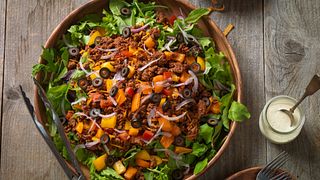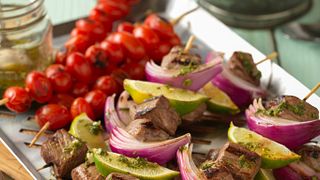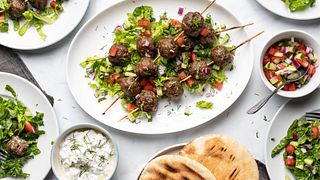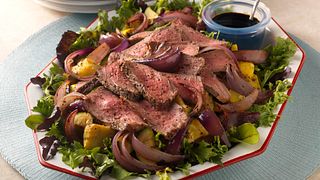beef in a plant-based diet
Plant-based diets are more popular than ever, but if you’ve thought you have to give up beef to follow a plant-based diet, you may be surprised to learn this is not the case! Continuing to include and enjoy a variety of foods in a plant-based diet will ensure you’re getting vital nutrients and sticking with the diet for the longterm.
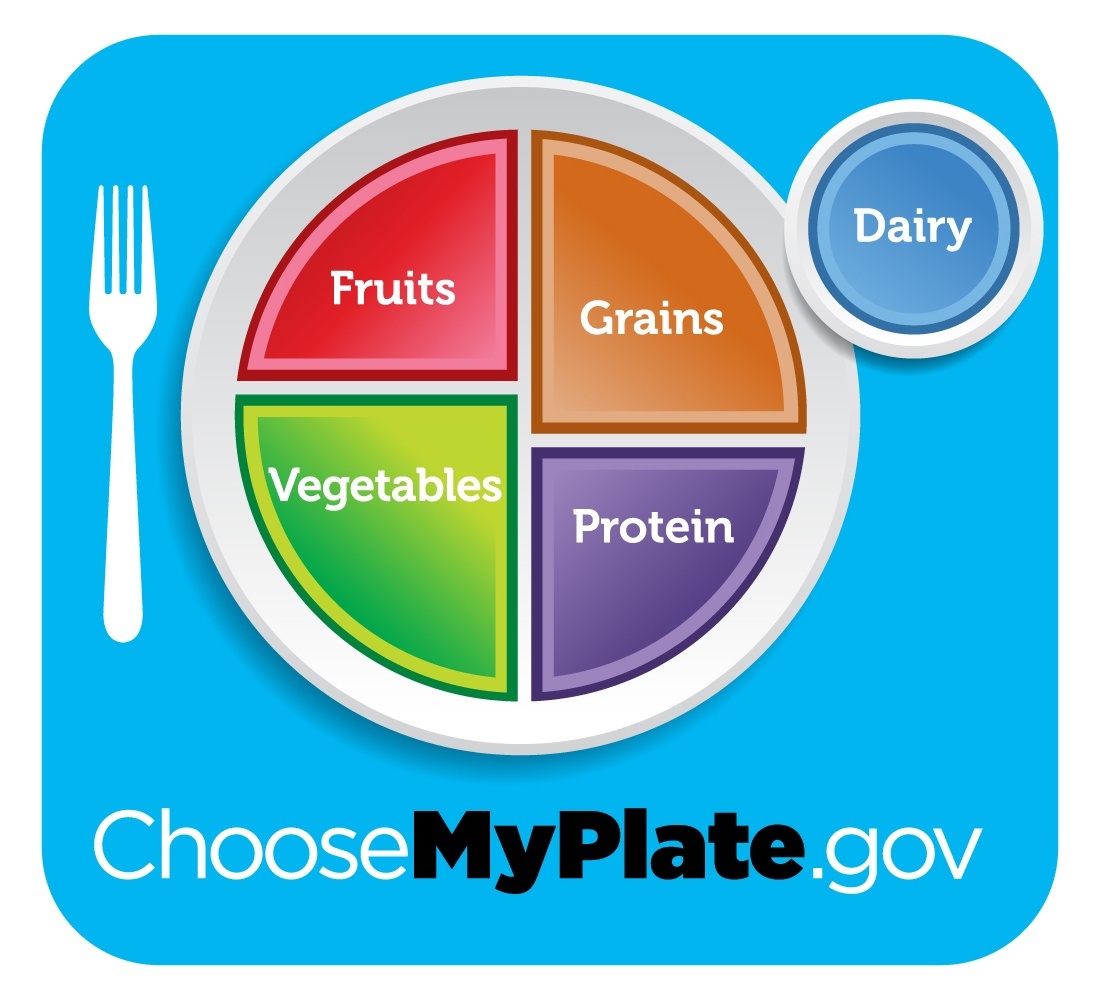
what is a plant-based diet?
Plant-based eating patterns focus on foods primarily from plants like fruits, vegetables, legumes, nuts, seeds, grains, and beans. This eating pattern can actually be visualized by thinking of USDA’s MyPlate, which recommends half of your plate includes fruits and vegetables, a quarter grains, a quarter foods rich in protein (both animal and plant sources), and a serving of low-fat dairy.
A plant-based diet doesn’t mean you have to follow a vegetarian or vegan diet, but rather that you are proportionally choosing foods to meet dietary guideline recommendations by filling half your plate with vegetables and fruits, a quarter of your plate with whole grains, a quarter of your plate with protein-rich foods, like lean beef, and rounding out your meal with low-fat dairy. Vegetarian diets completely cut out meat and vegan diets cut out all animal products and by-products. Because these diets eliminate a number of foods that contain essential nutrients such as vitamin B12, iron and zinc, planning needs to happen when following these diets to meet the recommendations of certain nutrients. Beef has been shown to help close many of those nutritional gaps:
Protein
A 3 oz portion of beef provides approximately half your Daily Value (DV) of protein (25 grams). This helps build and strengthen muscle, keeps you satisfied longer and helps maintain a healthy body weight.[1]
Iron
Iron is something that is hard to obtain from plants, and our bodies absorb the heme iron, like that available from beef, much easier. Iron helps transport oxygen from your lungs to every cell in your body. A 3 oz serving of beef provides approximately 14% of your daily value for iron.9
Zinc
Zinc is an important mineral for the brain and helps support a healthy immune system. A 3 oz serving of lean beef provides approximately 39% of your DV of zinc.1
Selenium
Selenium is an essential component in reproduction, thyroid hormone metabolism, DNA synthesis, and protection from oxidative damage and infection. A 3 oz serving of beef provides approximately 38% of your DV.1
Other nutrients
Other nutrients provided by beef are vitamin B6, niacin, riboflavin, vitamin B12, choline, and phosphorus. Avoiding or severely restricting meat consumption may compromise the delivery of the above nutrients, especially in adolescents and other vulnerable populations such as pregnant women or the aging population.10
nutrients from plant-based meat substitutes compared to beef
Some may think the solution to close nutrient gaps could be adding more plant-based beef substitutes, but one study found of the alternative meat options studied, less than 24% of the products were fortified with vitamin B12, 20% with iron, and 18% with zinc.11 When considering the nutrition beef provides, 93% lean ground beef can be lower in calories, fat, and sodium and provide more high-quality protein than some meat substitutes.


SURPRISING FACTS ABOUT BEEF NUTRITION AND HEART HEALTH
One common question about beef in the diet is, “What effect does consuming beef have on heart-health?” Research consistently shows a heart-healthy diet and lifestyle including lean beef, even daily, can reduce risk factors for heart disease such as blood pressure and blood cholesterol levels.3-6 A recent study found that following a Mediterranean-style eating pattern that includes up to 18 ounces of cooked, fresh lean red meat per week – along with other protein sources – is just as effective at improving certain heart disease risk factors (such as blood pressure and total and LDL cholesterol) as a Mediterranean-style eating pattern that limits red meat.2
Another common misperception about beef is related to the fat content beef provides in our diet. Many people are surprised to learn that half of the fatty acids in beef are monounsaturated – the same heart-healthy type of fat found in olive oil.7 Furthermore, approximately one-third of beef’s total saturated fat is stearic acid, which has been shown to be neutral in its effects on blood cholesterol levels in humans.8
With research studies consistently showing beef’s role in a balance and healthy diet, it’s not surprising that four ounces of lean beef as part of a healthy diet can improve health and reduce the risk of chronic disease. This includes having lean beef as part of a plant-based diet.
5 guidelines for creating a plant-based meal with beef
1. load up on vegetables
Aim to make half of your plate fiber-rich, non-starchy vegetables. Try to include two to three different colored vegetables to make a colorful plate that includes a variety of nutrients.

2. include whole grains
Include whole grains like brown rice, whole-grain bread, oatmeal, couscous, quinoa, or farro.
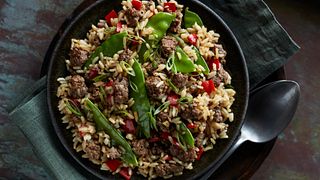
3. Focus on Specific Fats
Focus on including monounsaturated and polyunsaturated fat sources like avocados, olive oil, nuts, and seeds.
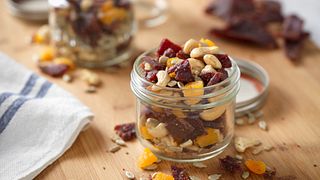
4. add some sweetness with fruit
Aim for 2 to 3 servings of fruit a day. Beef pairs well with a variety of fruits like apricots, peaches, pineapple, plums and prunes.

5. choose lean beef
Choose lean beef. Look for 93% lean ground beef or leaner or other cuts of beef that include key words such as “loin” or “round” in the name, which helps indicate a lean cut. Other popular lean cuts include Strip Steak and Flank Steak. Find more information about choosing lean cuts of beef here.
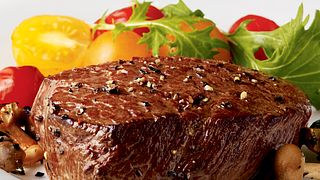
Since following a plant-based diet allows the freedom for all types of food groups, it makes it a more realistic and sustainable eating pattern for most. Eating a plant-based diet that includes beef and other animal products allows for flexibility, which can decrease a lot of the stress around eating. Enjoy the health benefits of a balanced plate while continuing to include healthy foods you already know and love.
some of our favorite plant-based recipes that include lean beef
Sources
- US Department of Agriculture, Agricultural Research Service, Nutrient Data Laboratory. USDA National Nutrient Database for Standard Reference, Legacy, NDB #13364. Version Current: April 2018. Internet: https://ndb.nal.usda.gov/ndb
- O’Connor LE, et al. A Mediterranean-style eating pattern with lean, unprocessed red meat has cardiometabolic benefits for adults who are overweight or obese in a randomized, crossover, controlled feeding trial. Am J Clin Nutr, 2018;108:33–40.
- Roussell MA et al. Beef in an Optimal Lean Diet study: effects on lipids, lipoproteins, and apolipoproteins. Am J Clin Nutr. 2012 Jan;95(1):9-16
- Roussell MA, et al. Effects of a DASH-like diet containing lean beef on vascular health. J Hum Hyypertens 2014;28:600-5.
- Layman D, et al. Protein in optimal health: heart disease and type 2 diabetes. Am J Clin Nutr. 2008;87:1571S-5S. .
- Sayer RD et al. Equivalent reductions in body weight during the Beef WISE Study: beef’s role in weight improvement, satisfaction and energy. Obes Sci Pract. 2017 Jul 11;3(3):298-310U.S. Department of Agriculture, Agricultural Research Service. FoodData Central, 2019. fdc.nal.usda.gov. NDB# 13364
- U.S. Department of Agriculture, Agricultural Research Service. FoodData Central, 2019. fdc.nal.usda.gov. NDB# 13364
- Hunter JE, et al. Cardiovascular disease risk of dietary stearic acid compared with trans, other saturated, and unsaturated fatty acids: a systematic review. Am J Clin Nutr 2010;91:46-63.
- Domellof M, Braegger C, Campoy C, Colomb V, Decsi T, Fewtrell M, Hojsak I, Mihatsch W, Molgaard C, Shamir R, et al. Iron requirements of infants and toddlers. J Pediatr Gastroenterol Nutr 2014;58(1):119-29
- McNeill SH, Van Elswyk ME. Meat: Role in the Diet. 1st ed. In: Caballero B, Finglas PM, Toldrá F, eds. Encyclopedia of Food and Health. Cambridge, MA: Academic Press, 2016:693-700. & American Academy of Pediatrics. Pediatric Nutrition Handbook. 7th ed. Elk Grove, IL: American Academy of Pediatrics, 2014.)
- Curtain F, Grafenauer S. Plant-Based Meat Substitutes in the Flexitarian Age: An Audit of Products on Supermarket Shelves. Nutrients. 2019;11(11):2603. Published 2019 Oct 30. doi:10.3390/nu11112603


